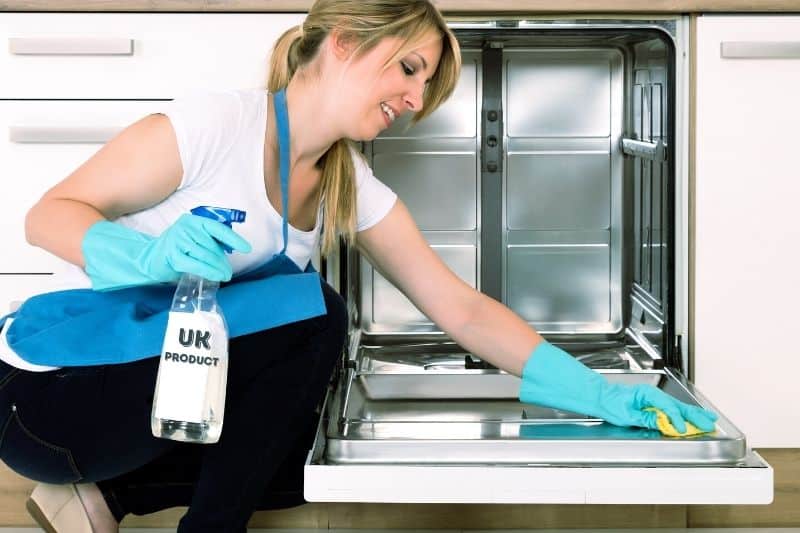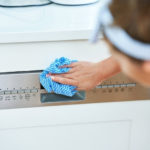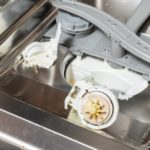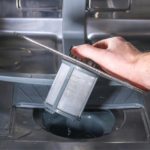Dishwashers can start to smell really rancid if they’re not cleaned often! Plus, if they’re not maintained, they won’t clean your dishes correctly.
The most important reason to clean a dishwasher is to keep the machine hygienic. Who wants horrible germs crawling over their wine glasses and plates?!
So, here’s how to clean a dishwasher by using products you can buy easily in the UK.
Parts to Clean in a Dishwasher
Before you start cleaning your dishwasher, it’s important to establish what parts actually need to be cleaned. Because, and I’ve done this myself, it’s very easy to leave a few key sections out when you’re cleaning your dishwasher.
Plus, if you don’t actually clean the areas listed below, your dishwasher will not be thoroughly clean!
So, the parts that you need to pay attention to are:
- Door (in and out)
- Racks (where the dishes go)
- Arm (water sprayers)
- Salt reservoir (where the dishwasher salt goes)
- Filter (catches the dirt)
- Seals (prevents leaks)
- Hinges (helps to open/close the door)
You might be thinking that this list is exhaustive, and it’ll take you an age to clean all of those sections. But, in reality, you won’t actually take that long to give your dishwasher a good clean.
And if you stay on top of your cleaning, a lot of these sections will remain relatively clean. So, every time you go to clean out your dishwasher, you’ll take less time to do so.
Let’s take a look at how to clean a dishwasher.
How to Clean a Dishwasher
Below is an in-depth step-by-step guide on how to clean your dishwasher.
But, if you’re stuck for time, or you’d prefer to purchase a cleaning product, skip to the section labelled ‘Specialised products’ to find out what products you can use to clean your dishwasher.
Step 1: Remove Goods
You need to remove any debris that you see leftover in the dishwasher. This could be old food, hair or sauce, for example. Dispose of them in your waste food bin/bin.
Also, remove any dishes.
Step 2: White Vinegar/Citric Acid
The next thing you should do to clean your dishwasher is to put 2 bowls of white vinegar inside the machine.
Put one bowl in the top rack, and put one bowl in the bottom rack. Then run a long, hot cycle. Doing this will help to remove any grease that’s built up, get rid of odours and in some cases, reduces limescale.
If white vinegar isn’t for you, you could follow the steps above and use citric acid instead.
Step 3: Bicarbonate of Soda
Sprinkle a small amount of bicarbonate of soda onto the bottom of the dishwasher. Then, start another hot wash. This also helps to remove any stenches and stains.
I’d like to point out that if you wish to stop after completing Steps 1, 2 and 3, this is okay because a lot of dirt will be gone by this point. However, if you want to give your dishwasher an even deeper clean, continue to follow the steps below.
Step 4: Door
The door is one place where pieces of food are likely to fall onto, so it’s worth giving this section a clean on a regular basis.
What you need:
- Cotton cloth
- White vinegar
- Hot water
Here’s what you need to do:
- Open the door.
- Make sure the dishwasher is off.
- Pop your Marigolds on.
- Grab a cotton cloth – no tough pads because they’ll scratch the door.
- Dip the cloth in a mix of white vinegar (1 part) and hot water (3 parts).
- Wipe the door down.
- For tougher dirt you may need to use more hot water/vinegar.
- Don’t forget to clean the buttons and the outside of the door.
How often should you do this?
Ideally, the door should be quite clean after the dishwasher has finished its cycle. So, you don’t need to clean the door too often, every few weeks is enough.

Step 5: Racks
The racks in your dishwasher are literally holding all your dirty pots, pans and plates. So, it’s vital that you clean these out. As with the door, the racks should be fairly clean after the dishwasher has finished its cycle, but there’s always the chance that food could be caught in the rack itself.
What you need:
- Hot water
- Cotton cloth
Here’s what you need to do:
- After every cycle, check the racks to see if they’re clean.
- If there’s dirt left behind, you need to clean the racks.
- Get a damp cotton cloth that has been soaked in warm water.
- Use this cloth to clean away the dirt that’s been left behind.
- Replace the racks.
If you like, you can try to spray a white vinegar (1 part) and warm water (3 parts) mix onto the racks to remove dirt. Simply spray and wipe the mix over the racks to clean them.
How often should you do this?
If you see dirt left behind on your dishwasher’s racks you should clean it away immediately. If you leave dirt behind, this debris will only end up on your next load of dishes.
Step 6: Sprayer Arm
It’s vital that you clean the sprayer arm in your dishwasher because if you don’t your plates won’t come out clean at the end of a cycle.
In a nutshell, the arm sprays water onto the plates in your dishwasher to clean them. If the arm is not maintained it will end up getting blocked up, either with food or limescale. This issue, if it’s not sorted out, can become very problematic.
What you need:
- Hot water
- Soft toothbrush
- Toothpick
- Wrench
Here’s what you need to do:
- Power off the dishwasher.
- Put your Marigolds on.
- Check your user manual to see how you remove the sprayer arm from your particular model – you usually need to loosen a bolt.
- Put the sprayer arm under the hot water tap.
- Soak the arm in the hot water.
- Use a soft toothbrush to remove any excess dirt you can see.
- You may need to insert a toothpick into the tiny holes you see in the sprayer arm – this is where the water shoots out of.
- Tease the dirt out gently.
- Make sure that you replace the sprayer arm properly in the dishwasher – you really don’t want to have a loose arm flying around!
How often should you do this?
Every 6 months. If you forget to clean the sprayer arm, dirt will build up. Eventually, when you run a washing cycle your dishes will not come out clean. This is the machine telling you that it’s time to wash the arm!
Step 7: Salt Reservoir
Dishwasher salts prevent limescale from building up in your dishwasher, so they play a pretty significant role. However, the salt reservoir, where you add the salt, gets clogged up with residue from time to time.
This is normal, but you do need to clean the reservoir out so that the salts can enter the machine and do their job properly.
What you need:
- Boiling water
- Cloth
Here’s what you need to do:
- Boil the kettle.
- Pour the water into the salt reservoir – that’ll loosen up any leftovers.
- Wipe the leftovers up with a cloth/they may disappear on their own.
How often should you do this?
Your dishwasher will usually tell you when it needs to be topped up with salt. So, a good time to clean the reservoir is at the same time. Or, you can just wash the salt reservoir out on a monthly basis.
Step 8: Filter
The filter is responsible for catching any waste food that comes off your plates before it gets trapped in the hose and causes a blockage. It’s usually a pretty dirty place because of this reason, and it’s actually a really important part to keep clean.
What you need:
- Hot water
- Soft toothbrush
Here’s what you need to do:
- Make sure your dishwasher is switched off.
- Put on some Marigolds.
- Find your filter – usually at the bottom of the dishwasher but check your user manual if you’re not sure.
- Pull out the filter – check your user manual for tips on how to do this.
- Go to your sink.
- Run hot water all over the filter.
- Use a soft toothbrush to remove any tough debris, if need be.
- Go back to where the filter popped out of and clean out any food you can see left behind – be careful.
- Replace the filter.
How often should you do this?
Weekly. You’ll be surprised by how much food this little filter catches, and it’ll become quite smelly if it’s left untouched.
Step 9: Seals
It’s vital that you keep your seals clean because if they start to break you won’t just have a dirty dishwasher on your hands, you’ll also have a leaky one too. And although seals can be repaired, it’s usually a needless expense that could be avoided.
What you need:
- Cotton cloth
- Hot water
Here’s what you need to do:
- Make sure the machine is powered down.
- Put your Marigolds on.
- Grab a cotton cloth.
- Soak the cotton cloth in hot water.
- Run the cloth over the seals to clear away any dirt.
If you like, you could try spraying a white vinegar (1 part) and warm water (3 parts) mix onto the seals to keep them clean. Simply spray and wipe the mix over the seals.
How often should you do this?
Seals should be wiped down weekly, at a minimum.
Step 10: Hinges
Keeping the hinges on your dishwasher clean is one way of making sure that they keep on working. All manner of dirt can get trapped in the hinges, so giving them a quick clean can prevent them from breaking.
What you need:
- Soft toothbrush
- Warm water
- Cotton cloth
- Toothpick
Here’s what you need to do:
- Locate your hinges – usually at the bottom of the door if you have a freestanding dishwasher.
- Make sure you wear your Marigolds.
- Get a soft toothbrush and start rubbing away at any dirt that you see stuck in the hinges.
- Use a cotton cloth that has been soaked in warm water to remove tough dirt.
- You might need to use a toothpick to scrape out any dirt that is stuck.
How often should you do this?
Every few months. The majority of the dirt should be inside the dishwasher, so only small amounts of debris should really get to this section.
Although, if you tend to drop sauce, for example, down the side of the inner door, you may need to clean this area more often.
Step 11: Hot Cycle
Once you’ve cleaned all the areas listed above, your dishwasher should be in pretty good condition. All you need to do now is run an empty hot cycle, clean away any final pieces of dirt/product and make sure everything is working okay.
Specialised Products
Not everyone has time to thoroughly clean their dishwasher. So, if you find yourself slotting into this category, you’ll be pleased to hear that there are lots of dishwasher cleaning products available for you to buy and use.
With so many products on the market, and each item has its own positives and negatives, it can be difficult to choose what to buy. See our roundup of the best dishwasher cleaner products and choose one that is right for you.
If you do decide to use a product to clean your dishwasher, you should follow the instructions of the packaging of the item. Each item does work differently, and there might be pre-cleaning and post-cleaning steps to follow.
If you do choose to use a product, I’d advise you to clean at least some of the sections I’ve discussed above as well. That’ll help to keep your dishwasher working for longer and it’ll improve the overall hygiene level of the appliance too.
Don’t Use
While there are many products you can use to clean a dishwasher, you should avoid these particular ones:
- Don’t use bleach in stainless-steel dishwashers
- Harsh chemicals
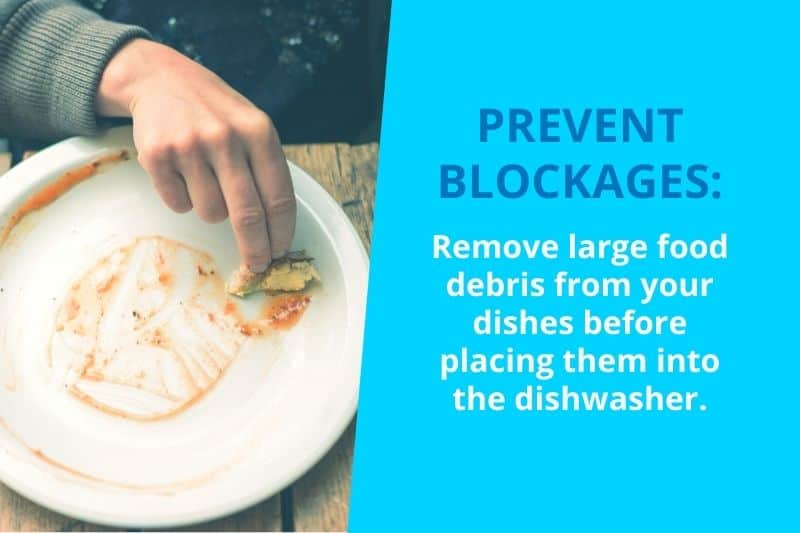
Preventative Measures
If you’re not a big fan of tackling dirty and smelly dishwashers, follow these tips to keep your dishwasher relatively clean.
- Don’t put massive chunks of food in your dishwasher – use your food bin to get rid of waste food.
- Regular cleaning will prevent build-ups of dirt.
- If you see blockages appearing, get rid of them quickly.
- If you’re stuck for time, use specialised dishwasher cleaners to keep on top of your cleaning.
- Run an empty but hot wash every 6 months to clear out any food build-ups in the machine. Plus, it’ll help to remove poor smells.
Conclusion
Cleaning a dishwasher is vital. Not only will cleaning it keep it working for longer, but it’s also hygienic to do so.
You can either clean your dishwasher by completing steps 1, 2 and 3 above, or you can follow all the steps to perform a deep clean of your dishwasher, or you can buy a product in.
It’s entirely up to you!
FAQs
Do I need to call a professional in to clean my dishwasher?
Ideally, you should be able to clean a dishwasher yourself. You can either follow the steps above, or you could buy a product to clean the dishwasher for you. Professional help usually comes with a price tag, so you really need to weigh up the pros/cons of this method before you go ahead.
How do I unblock a dishwasher?
Unblocking a dishwasher doesn’t need to be a difficult task. All you need to do is find the source of the problem and fix the issue accordingly. Read our article for more advice!
Can I just use soda crystals to clean the dishwasher?
No. You can find out why you shouldn’t use soda crystals in a dishwasher here.

Bethan has a passion for exploring, reading, cooking and gardening! When she’s not creating culinary delights for her family, she’s concocting potions to keep her house clean!
